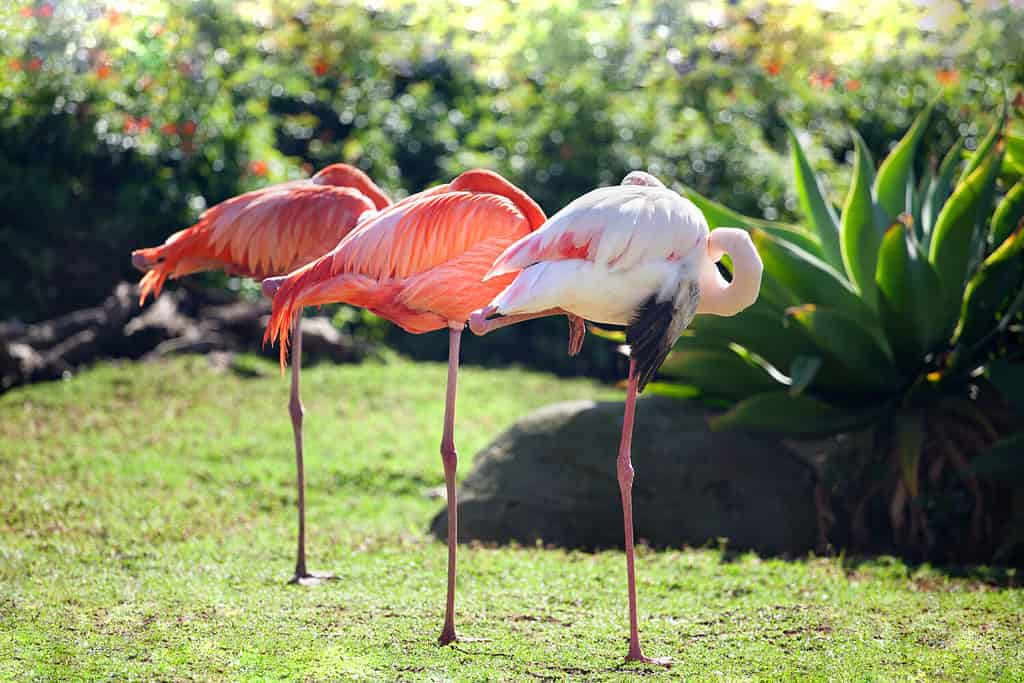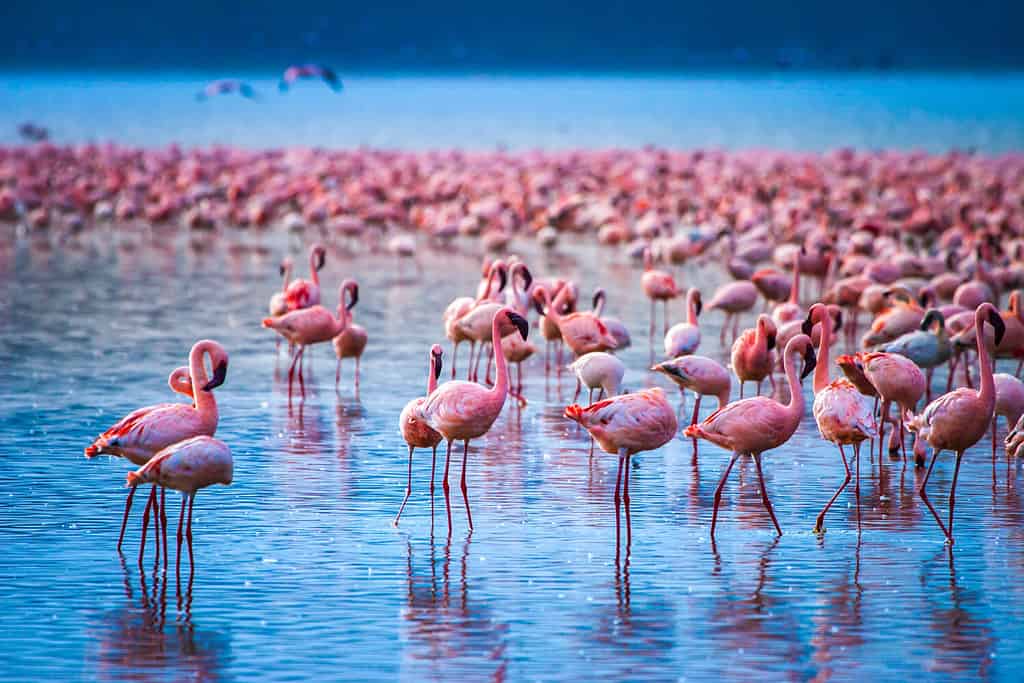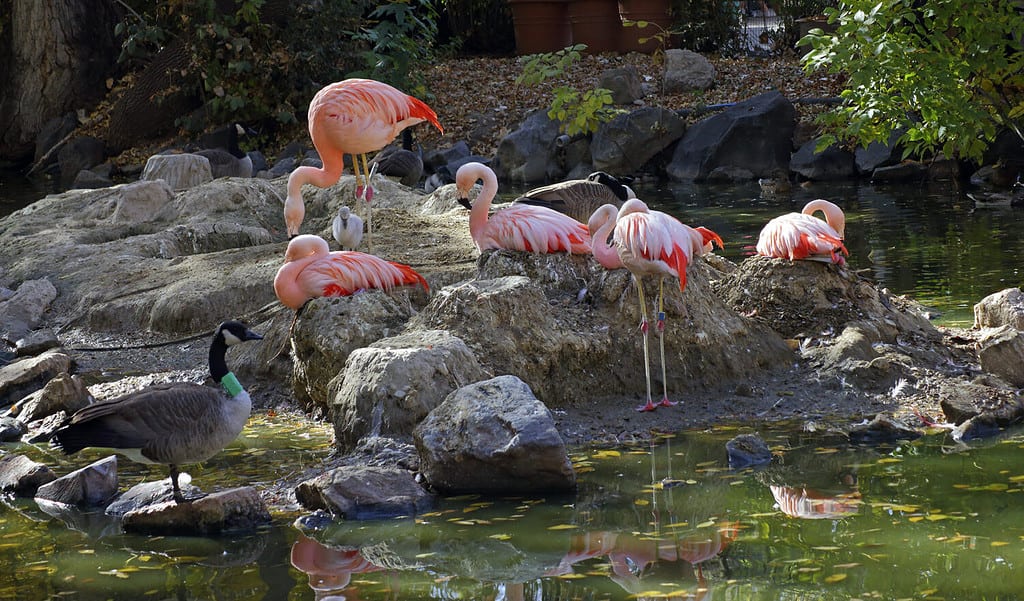We’ve all come to know flamingos as beautiful birds who boast quite a unique coloration. Although some people may think that flamingos are naturally pink, the truth is that they develop this color throughout their lives! Today, we’ll discover why flamingos are pink and share some fun facts about this exotic and attention-grabbing bird.
Flamingos: A Brief Overview

Flamingos belong to the family Phoenicopteridae.
©Jckfreder/Shutterstock.com
The oldest flamingo fossils are millions of years old, meaning that the ancestors of these birds roamed the Earth long before mankind. Today, six species of flamingos exist across the globe: the puna flamingo, the Chilean flamingo, the lesser flamingo, the greater flamingo, the Andean flamingo, and the Caribbean flamingo. Among these, the greater flamingo is the most abundant, while the Andean flamingo is the rarest. Flamingos are found in many different countries, such as Argentina, the United States, India, Spain, Mexico, and Jamaica. However, the largest colony of these gorgeous birds is located in northern Tanzania. Although spotting them in their natural habitat is relatively easy, many species are migratory. If you’d like to see flamingos all year round, visit a zoo!
Flamingos are social animals who prefer to live in communities rather than remain solitary. In addition, they are monogamous, and couples usually collaborate on building a nest and feeding their young. After their chick has hatched, they care for it for a few weeks before the young flamingo leaves to join a creche, or group of adolescent flamingos. It takes roughly three to five years for flamingos to reach maturity and go on to create families of their own.
How Flamingos Get Their Color

Although it may not look comfortable, flamingos can sleep while standing on one leg.
©Vera NewSib/Shutterstock.com
Many people believe that flamingos get their color from eating large amounts of shrimp, but this is not the case; at least not directly. Flamingos actually get their color from a pigment called beta-carotene that exists within the food that they eat. This pigment is actually the same one that is responsible for giving carrots their orange hue! Shrimp and algae are common parts of their diet, and they are jam-packed with this pigment. As they digest and metabolize the beta-carotene, and it manifests in their beautiful, pink-toned feathers.
Flamingos are born white, and throughout their life, they develop their pink color through the food they eat. This is also why flamingos appear in a variety of shades, and members of the same colony can display great variance. The diet of each individual bird is unique, and so too are their levels of beta-carotene. As a general rule, most flamingos range in color from pure white to orange-salmon tones and reddish bright pink.
What Is the Rarest Color of Flamingo?

Flocks of flamingos can consist of hundreds or even thousands of birds.
©FOTOGRIN/Shutterstock.com
You may be wondering which is the rarest flamingo color of all, and the answer will surprise you. Although we’ve only discussed bright reddish colors, the rarest flamingo color is black! According to a study authored by Juan A. Amatand Miguel A. Rendón, “Feather carotenoids were likely replaced in such an individual by melanin in all its plumage and bare parts. The black plumage of this individual may have resulted from a genetic mutation that interrupted the metabolic processes responsible for the deposition of carotenoids into feathers.” This makes their presence exceedingly rare and spotting one is a once-in-a-lifetime event.
Fun Facts About Flamingos

Despite how delicate they appear, flamingos are excellent fliers.
©Mikhail Pogosov/Shutterstock.com
Although flamingos are famous around the globe, there are a handful of lesser-known facts about these interesting birds. Shockingly, flamingos have a very long life, and many live between 20 and 30 years in the wild. In captivity, their lives can be even longer, ranging between 40 and 60 years! The oldest flamingo lived to be a whopping 83 years old!
A flock of flamingos is called a “flamboyance,” and in a crowd, you might spot some of them standing on one leg. But why do they do this? Some research suggests this helps them regulate their temperature, while others argue that this may be a signal that the flamingo is entering a “half-awake” state. Alternatively, many believe that flamingos engage in this behavior in an attempt to save energy. Even though it might not look like it’s comfortable or easy, this pose is part of the flamingo’s physiology. When they’re on one leg, they don’t have to worry about balancing, and as such, it’s easier for them to rest.
Final Thoughts
From their coloration to their unique one-legged stance, flamingoes display a wealth of curious qualities that have captured attention throughout the years. As we learn more about these brightly colored birds, we’re continually surprised by each additional discovery!
The photo featured at the top of this post is © Vera NewSib/Shutterstock.com
Thank you for reading! Have some feedback for us? Contact the AZ Animals editorial team.






